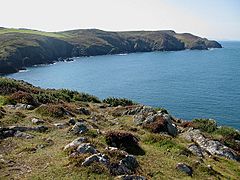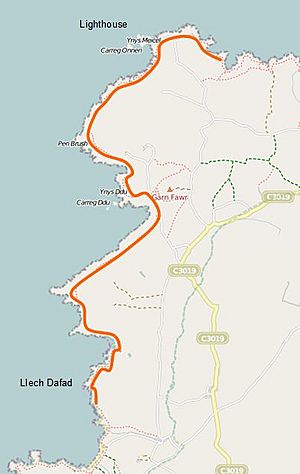Strumble Head - Llechdafad Cliffs facts for kids
| Site of Special Scientific Interest | |

Carreg Onnen Bay from Strumble Head.
|
|
| Area of Search | Pembrokeshire |
|---|---|
| Coordinates | 52°00′14″N 5°04′17″W / 52.003927°N 5.0714756°W |
| Interest | Biological and Geological |
| Area | 204.63 ha |
| Notification | 1954 |
Strumble Head - Llechdafad Cliffs is a very special area in Pembrokeshire, Wales. It's officially called a Site of Special Scientific Interest (SSSI). This means it's a place that has unique plants, animals, or rocks that need to be protected.
This SSSI was first recognized in January 1954. The goal was to keep its amazing natural features safe. It stretches along the coast for about six miles. You can find it on the western side of the Strumble Head area.
The site goes from the Strumble Head Lighthouse in the north down to a cliff called Llech Dafad in the south. In Welsh, Llech Dafad means 'sheep slab'. This whole protected area covers about 204.63 hectares. That's like 500 football fields! Natural Resources Wales helps to look after it. The closest town is Goodwick, which is about four miles away.
Contents
Why Strumble Head - Llechdafad Cliffs Are Special
This SSSI is important for two main reasons: its amazing geology (rocks and landforms) and its diverse biology (plants and animals). It has six main features that make it so unique:
Coastal Habitats
The cliffs and coastline here create perfect homes for many different species.
Maritime Cliffs and Ledges
The tall cliffs and rocky ledges are home to special plants that can handle salty air and strong winds. Birds also use these ledges for nesting.
Coastal Grassland
Right next to the sea, there are areas of grassland. These grasses are tough and can grow where other plants might struggle. They provide food and shelter for insects and small animals.
Coastal Heath
Heathland is a type of open land with small, tough shrubs. The coastal heath at Strumble Head is a beautiful mix of plants that thrive in the windy, exposed conditions near the sea.
Dry Heath
Further inland, away from the direct sea spray, there's dry heath. This habitat also has hardy plants and is important for different kinds of wildlife.
Rare Plants and Animals
Because of its unique habitats, Strumble Head - Llechdafad Cliffs is home to some plants and animals that are not found easily elsewhere.
Protecting Rare Species
The SSSI status helps protect these rare plants, making sure they can continue to grow and thrive. It's like a special nature reserve for them.
Amazing Wildlife
This area is also a great place for wildlife. You might spot a chough, which is a type of crow with bright red legs and a curved red beak. It's a rare bird that loves coastal areas. You could also see the small blue butterfly, which is one of the smallest butterflies in the UK.
Geology: Ancient Rocks
The rocks at Strumble Head - Llechdafad Cliffs tell an incredible story about Earth's past.
Ordovician Igneous Rocks
The rocks here are from a time called the Ordovician period, which was about 485 to 443 million years ago! These are "igneous" rocks, meaning they were formed from molten rock (magma or lava) that cooled and hardened. They show us how the Earth's crust was formed and changed over millions of years. Studying these rocks helps scientists understand our planet's history.


